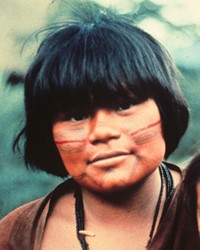Matsigenka, Manaries in Peru

Photo Source:
Anonymous
|
Send Joshua Project a map of this people group.
|
| People Name: | Matsigenka, Manaries |
| Country: | Peru |
| 10/40 Window: | No |
| Population: | 24,000 |
| World Population: | 24,000 |
| Primary Language: | Matsigenka |
| Primary Religion: | Christianity |
| Christian Adherents: | 60.00 % |
| Evangelicals: | 2.00 % |
| Scripture: | New Testament |
| Ministry Resources: | Yes |
| Jesus Film: | Yes |
| Audio Recordings: | No |
| People Cluster: | South American Indigenous |
| Affinity Bloc: | Latin-Caribbean Americans |
| Progress Level: |
|
Introduction / History
The Matsigenka dwell in southeastern Peru, where a cloud forest separates the highlands and high forest. Because of this geographical landscape, influences from other groups were limited to trade. The early 20th century brought the slave trade to their region. Colonists traded shotguns, steel tools and other items with the Matsigenka in exchange for captives. These colonists also brought detrimental diseases, causing native populations to dwindle. As Amerindians were relocated, native groups were forced to struggle against each other for resources.
What Are Their Lives Like?
Despite colonial influence, the remaining Matsigenka have preserved their cultural identity while adopting some modern Peruvian tradition. Their original language of Matsigenka, a dialect of Arawak, is broken into two subgroups: Matsigenka and Caquinte. “Matsigenka” itself means “people.” Spanish and Asháninka are also spoken.
Heavy rainfall has shaped the lifestyle those in the upper Amazon of southeastern Peru. The combination of wet seasons and mountainous regions brings the threat of floods and earthquakes. The Matsigenka reside in small settlements, preferably near water and atop a hill or ridge. These locations, in addition to providing protection from natural disasters, support slash-and-burn farming. For part of the year, they travel nomadically.
Time continues to be counted by moons, travel by the sun. The moon is honored by the monthly Moon Festival. Singing is central to celebrations.
Crimes are punished by shaming or ostracization from the community. Politics are minimized by household autonomy. The Matsigenka are hospitable and generous to each other, but history has taught them to be cautious of outsiders.
What Are Their Beliefs?
Catholicism is a dominant religion but is understood through the context of a fear-power culture. Cultural religions still influence their understanding of the world. The origin myth of the Matsigenka tells of their creation from wood. The creator spirit, Makineri, brought them to life by his breath and singing.
Many myths describe the myriad of “Tasorinchi” spirits, who can influence one's fortune in the world.
Bad spirits can be found in caves and mighty winds. The “Kamagárini,” or demons, emerge from the underworld.
Happiness colors the Matsigenka's understanding of morality. Spirits are honored for their ability to bring curses or blessings. Even animals are believed to have spirit rulers, preventing excess hunting. After death, the spirit world continues to play a central role. Cultural religion teaches ten levels of existence. Souls who fly beyond the seventh level after death have the opportunity to reach eternal happiness, but bad spirits may drag such a soul down during the journey. Death rituals are dominated by a fear of bad spirits, causing the family to avoid weeping and remembrance of the deceased.
What Are Their Needs?
Malnutrition, increased suicide rates, alcoholism and lack of medical resources all affect the Matsigenka population. Infant mortality rate remains high. Some settlements are more isolated than others, deepening many resource-related needs. Isolation can be a barrier in reaching these groups with the gospel.
Prayer Points
Pray for God to intervene on behalf of the Matsigenka. Ask God to send workers to this people group who can specifically meet physical and spiritual needs. Pray for Christ to be magnified through active multiplication of disciples, some of which can take the Gospel beyond the Matsigenka and to the ends of the earth.